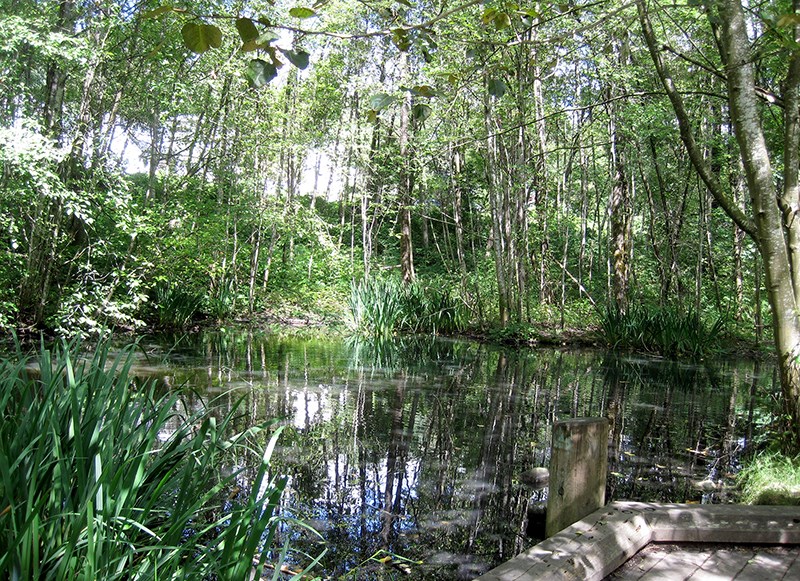Over the years, it has been sad to witness the loss of wetlands as our communities have become ever more developed.
Often, these wetlands get covered for use as playing fields. Sometimes, they simply get buried beneath fill and built upon.
As an example, the Onni site in Port Moody was once full of wetlands prior to development. There, on the west side of Suterbrook Creek, an extensive wetland would form every spring and evaporate over the summer. When its water level was very high, flow would occur to Suterbrook but because this wetland was, for the most part, isolated from the stream. it was impossible to have it protected under the guidelines for stream protection.
Until its eventual disappearance, I followed the fate of this wetland over several years. During that time, I learned how important ephemeral (i.e., seasonal) wetlands are for our native frogs. I discovered this wetland was an excellent breeding site for both tree frogs and red-legged frogs (a species at risk), plus two salamander species, the long-toed and northwestern. The chorus of tree frogs from this wetland was almost deafening each spring. In contrast, the larger red-legged frog is a much quieter species whose call is rarely heard.
During one especially dry summer, this wetland threatened to evaporate before the tadpoles or salamander larvae could metamorphose into their adult forms. These juveniles, which, amazingly, could sense decreasing water levels, started to transform into adults, although they were unusually small. At the same time, local predators, such as raccoons, found the shrinking wetland pools created easy opportunities to capture these bite-sized amphibians. That summer, my two young two sons and I hauled buckets of water from nearby Suterbrook Creek on a daily basis to give these young amphibians a few extra days to transform and then make their escape into the nearby forest.
Eventually, it became clear that development at Suterbrook was inevitable and the wetlands would, for the most part, be lost. A plan to create an alternative wetland within the Shoreline Park began to occupy my mind. Near the so-called old mill site in this park, I knew water often seeped from the hillside just below the railway tracks. In winter, this water would sometimes freeze over an old concrete base of a former shed and create a temporary skating rink.
I suggested to city staff a wetland would be an attractive feature to have in the park and recommended the concrete be removed and a hole dug to contain the water. Thankfully, my suggestion was taken up by the city and work was initiated to create a wetland. Because natural water seepage proved to be insufficient to fill the wetland, we partially diverted water from a small buried stream that conveniently flowed year-round from a culvert just below the bike path.
This wetland complex was created in two stages; a second excavation adjacent to the first wetland was intended to become a cattail marsh where red-winged blackbirds could nest. The Onni site was replete with cattail marshes that supported several nesting pairs of red-winged blackbirds. But until we created such a marsh within Shoreline Park, this bird was only a rare winter visitor to the park.
One spring, when development was imminent on the Onni site, became the time to transfer the amphibians. In fact, we planned to move only their eggs to the new wetland and leave the adults behind in the hopes that they might still manage on a site even with their habitat significantly reduced. Once again, we had excellent cooperation from not only city staff but also the environmental consultants hired by the developer of the Onni site.
On the day of the transfer, the water level in the wetlands was, first, reduced by pumping. This allowed us to identify where most of the eggs had been laid as they hung in clusters from the dead limbs of trees that had been blown into the pond during winter windstorms. Reducing the water level simply made the egg clusters visible. We quickly waded in to collect the eggs in buckets of water by clipping the branches off with minimal disturbance and no touching of the eggs.
We also collected a few root balls of cattails to plant in the new wetland. Then, we were off to the new wetlands with all our eggs in several buckets of water. The transfer was quickly accomplished and, then, it was all up to nature…
Every spring, there is now a steady chorus of tree frogs at these wetlands. As for the fate of the red-legged frogs, we are a little less sure. The surrounding forest is rather dry for adult frogs, although there are small areas which remain damp throughout most of the year.
Last year, for the first time, a red-legged frog was observed at the nearby Noons Creek Hatchery pond. We took this sighting as an indication the frog may have originated from the old mill site wetlands and was moving out in search of new territory.
We have been delighted with the outcome of the transfer we did so many years ago. And it just goes to show that when nature is given a chance, she rebounds profusely.
--Elaine Golds is a Port Moody environmentalist who is president and conservation chair of the Burke Mountain Naturalists, and member of the boards of the Colony Farm Park Association and the Port Moody Ecological Society.



